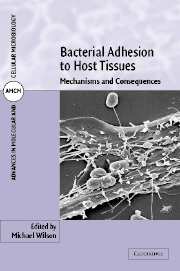Book contents
- Frontmatter
- Contents
- List of contributors
- Preface
- Part I Bacterial adhesins and adhesive structures
- Part II Effect of adhesion on bacterial structure and function
- Part III Consequences of bacterial adhesion for the host
- 10 Adhesion, signal transduction and mucosal inflammation
- 11 Adhesion of oral spirochaetes to host cells and its cytopathogenic consequences
- 12 Interactions between enteropathogenic Escherichia coli and epithelial cells
- 13 Host cell responses to Porphyromonas gingivalis and Actinobacillus actinomycetemcomitans
- Index
- Plate section
12 - Interactions between enteropathogenic Escherichia coli and epithelial cells
Published online by Cambridge University Press: 08 October 2009
- Frontmatter
- Contents
- List of contributors
- Preface
- Part I Bacterial adhesins and adhesive structures
- Part II Effect of adhesion on bacterial structure and function
- Part III Consequences of bacterial adhesion for the host
- 10 Adhesion, signal transduction and mucosal inflammation
- 11 Adhesion of oral spirochaetes to host cells and its cytopathogenic consequences
- 12 Interactions between enteropathogenic Escherichia coli and epithelial cells
- 13 Host cell responses to Porphyromonas gingivalis and Actinobacillus actinomycetemcomitans
- Index
- Plate section
Summary
INTRODUCTION
Each year diarrhoeal diseases contribute to the deaths of more than 2 million people in developing countries, most of whom are children. Enteropathogenic Escherichia coli (EPEC) is an important cause of diarrhoea in young children and makes a major contribution to infant morbidity and mortality in the developing world. A striking feature of EPEC diarrhoea is the age-dependent susceptibility of patients. Infections occur primarily in children less than 2 years of age and symptoms are usually acute but may be very severe and protracted (Nataro and Kaper, 1998). Patients routinely experience profuse watery diarrhoea, but vomiting and low grade fever are also common symptoms. EPEC rarely causes diarrhoea in adults and in volunteers only at very high doses (Donnenberg et al., 1993; Tacket et al., 2000)
EPEC is principally a pathogen of the small bowel and one of several gastrointestinal pathogens of humans and animals able to cause distinctive lesions in the gut, termed attaching and effacing (A/E) lesions. This group of A/E pathogens includes the closely related human pathogen enterohaemorrhagic E. coli (EHEC) (see Chapter 9), and the animal pathogens, rabbit enteropathogenic E. coli (REPEC) and Citrobacter rodentium (Nataro and Kaper, 1998). The remarkable histopathology of A/E lesions can be observed in intestinal biopsies from patients infected with EPEC and other host species. The lesions are characterized by localized destruction of intestinal microvilli, intimate attachment of the bacteria to the host cell surface and the formation of pedestal-like structures underneath tightly adherent bacteria (Fig. 12.1) (Frankel et al., 1998; Vallance and Finlay, 2000).
- Type
- Chapter
- Information
- Bacterial Adhesion to Host TissuesMechanisms and Consequences, pp. 277 - 298Publisher: Cambridge University PressPrint publication year: 2002



